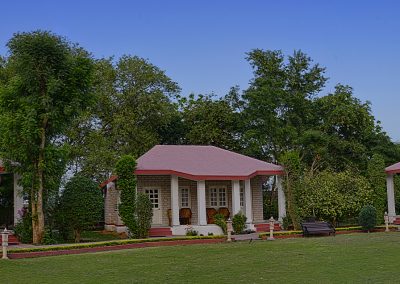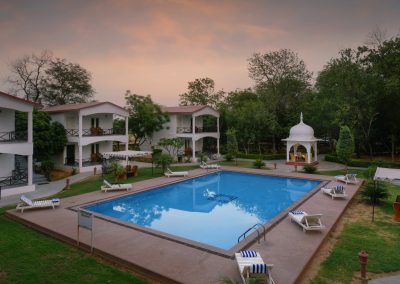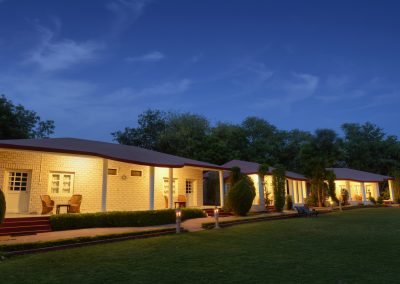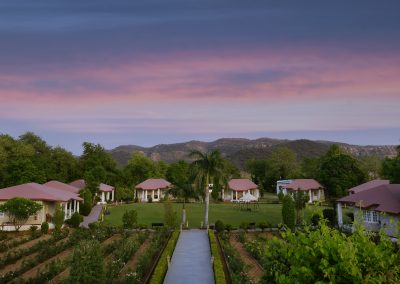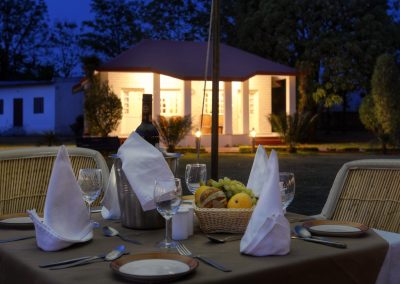Ranthambore National Park
The name Ranthambore is said to be derived from two hills in the area, Ran and Thanbor. Another explanation is that Ranthambore was once called Rana Stambhapura or City of the Pillars of War.
The Ranthambore National Park was the hunting ground of The Maharajah of Jaipur. In 1955, it was declared a game sanctuary; in 1980, it became a National Park. When Project Tiger was commissioned in 1972, it was included in the project. With the addition of neighbouring Keladevi and Mansingh sanctuaries, the total area of the National Park stands at 1,334 sq km. But the entire Park – the core area is just 392 sq km – is not open to the public. The Ranthambore Park is set between the Aravalli and Vindhya ranges. Its deciduous forests were once a part of the magnificent jungles of Central India. The terrain is rugged and there are rocky ridges, hills and open valleys with lakes and pools.
Ranthambore is a heritage site because of the picturesque ruins that dot the wildlife Park. There are lake palaces, ‘chhatris’, old fortifications and a majestic 1,000-year-old fort, overlooking the Park. The lovely Jogi Mahal is located at the foot of the fort and gives a magnificent view of the Padam Talao, painted white with water lilies. The Ranthambore Park is famous for tigers and due to conservation efforts; the tiger population has stabilized if not increased here. The tigers can be spotted quite often even during the day, at their normal pursuits – hunting and taking care of their young ones. Ranthambore is one of the best places to see these majestic predators.
Prime Attractions of Ranthambore National Park
The most fascinating and most popular excursion taken from the National Park is to the Ranthambore Fort. This fort was built by the Chauhans in the 10th century. The fort is located at a very strategic position between north and central India and hence it was always coveted by many rulers. This fort is famous for the ‘Johar’ (suicide by immolation to escape humiliation) by Rajput women in 1301 AD during the siege by Ala-ud-din Khilji. The temples and tanks add to the beauty of the fort. The seven gates and massive curtain walls, crowning a fall-topped hill, present a majestic view.
Flora & Fauna in Ranthambore National Park
Ranthambore is a dry deciduous forest with dhok (Anogeissus pendula) trees as the main vegetation which is an important fodder tree for animals. Kulu (Sterculia urens), ronj (Acacia leucophloea), ber (Zizyphus mauritiana), khimi (Manilkara hexandra), tendu (Diospyros melanoxylon), polas (Butea monosperma), peepal (Ficus religiosa), mango and banyan are prevalent in Ranthambore. But perhaps the most spectacular is the flame of the forest which blooms in April, enveloping the forest in a spectacular fiery red aura. The four lakes in Ranthambore are surrounded by numerous species of trees like salar (Boswellia serrata) and gurjan (Lannea coromandelica).
Among the more fascinating features of Ranthambore are the banyan trees, some of which are known to be at least 800 years old and are mentioned in ancient texts. Ranthambore can also boast of the superb specimen of the banyan tree that casts its magnificent canopy behind Jogi Mahal, the old hunting lodge by the lake built in the latter part on the last century by the Maharaja of Jaipur.
Ranthambore National Park spans an area of about 400 sq km with a tiger population of about 32. The tiger is relatively easier to spot in Ranthambore than in many other National Parks, thanks to the tourist friendly nature of the tigers and the openness of its surroundings. The Park also supports a large number of other wild species including leopards, the highly endangered caracal, jungle cat, hyena, jackal, sloth bear, wild boar, marsh crocodile, porcupine, common langur, spotted deer, Indian gazelle, sambar (Asiatic stag) and nilgai (Blue bull). Some of these species (especially the nocturnal ones like the leopard and the caracal) are difficult to spot and sightings are rare, but then that is bound to happen when every eye in the Park is looking for what Ranthambore is best known for – the tiger.
The langur is the only primate found in Ranthambore and is abundant in these forests. It is not the tiger’s best friend. Actually it is a source of great annoyance to the tiger, since it has remarkable eyesight and from its high perch it can spot the slightest movement; its shrill alarm call effectively warns all the other animals of danger. But if you are looking for tigers you should be listening carefully, a langur’s alarm call, or for that matter a chital’s (spotted deer) call, might be a good indication of the presence of a tiger in the area.
Another animal that is sure to come your way in Ranthambore is the sambar. It is among the tiger’s favourite prey. Largest of the Asiatic deer, the sambar stands some 1.5 metres at the shoulder and weighs more than 270 kilograms.
Ranthambore is also rich in migratory, water, and woodland birds. There are about 270 species of birds in the Park including a large number of migratory birds. Some of the many varieties of birdlife to be found here are the great Indian horned owl, various species of eagles such as Bonelli’s eagle and the crested serpent eagle, spoonbills, partridge, quail, parakeets, kingfishers, owls, storks, geese and ducks. But perhaps the most visible bird in Ranthambore is the peacock, India’s national bird. Every evening the peacocks of Ranthambore line up on the walls of the fort which stands on a cliff above the Park and, after much calling, descend to specific roosting trees for the night.
Safaris
The most exciting aspect of a visit to a wildlife sanctuary is the safari into the jungles, of meeting the unexpected and completely missing the expected. Animals can be seen in a zoo also, but the dangerous thrill of actually encountering a wild beast in its natural habitat is a sure method of testing one’s patience and bravado.
The Park is open from October to April, after which the monsoons make it impossible to enter forests as the muddy trails are washed away. The best times to view wildlife are the early mornings and evenings, as fixed by the forest department, and in Ranthambore there is a fairly good chance of spotting a tiger. A network of four tracks crisscross the park. A maximum of three open jeeps are allowed on each trail at a time. There are open roofed canters (small trucks) but these are not very good for viewing wildlife as they seat 20 people who can get really excited on seeing an animal and scare it away. Also, canters are shaky vehicles and photography is nearly impossible from them because their drivers stop and start on their own whims and without warning. Rides into the jungle in open jeeps are pretty safe as most of the wild animals are accustomed to human presence.
Best Time To Visit
The best time to visit the Park is from October to March. Jeeps can be booked up to five months in advance and even the day before. Each safari takes about three hours.
General Information
» 165 km from Jaipur which is the nearest airport. Nearest railhead is Sawai Madhopur (12 km).
» Average rainfall – 800mm
» Temperature – Min 4 0C, Max 47 0C
SPEAK TO TRAVEL CONSULTANTS NOW, TO GET TRAVEL ADVICE
Call us: 01273 855660 or Email us: info@lindiawildlife.co.uk


